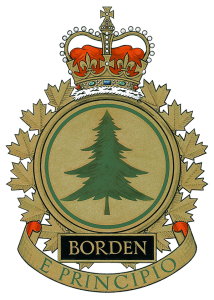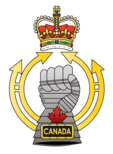 CFB (Canadian Forces Base) Borden is located approximately 100km north of Toronto, Ontario. Employing around 3,250 military members and 1,500 civilians, CFB Borden is the largest Canadian Armed Forces training establishment.
CFB (Canadian Forces Base) Borden is located approximately 100km north of Toronto, Ontario. Employing around 3,250 military members and 1,500 civilians, CFB Borden is the largest Canadian Armed Forces training establishment.
In May of 1916, construction of a new camp began by three companies of the 157th (Simcoe Foresters) Battalion under Lt-Col D.H. MacLaren. Before the camp opened, the remainder of the 157th and whole 177th Battalion (Simcoe Foresters) were on site to complete the construction.
The base was officially opened July 11, 1916 by the Minister of Militia and Defence Major-General Sir Sam Hughes. The base was named after Sir Frederick Borden, (1847-1917; Minister of Militia and Defence 1896-1911).
It was a primary base for the training of troops during the First World War. By the end of 1916, 36 Infantry Battalions of the Canadian Expeditionary Force were training for overseas service at Camp Borden. Over half of all soldiers who served during the World Wars received some or all of their training at Borden.
Borden is also the home of the Royal Canadian Air Force. The first training wing and airfield opened 2 May 1917 under the auspices of the Royal Flying Corps. (The RCAF was authorized in 1924, at which time, RCAF Station Camp Borden was the largest military airfield in the world.) RCAF Station Camp Borden and Canadian Army Camp Borden remained as two separate camps until 1966 when they joined to become CFB Borden.
The Royal Canadian Signals established a Depot at Camp Borden in 1923. Around 1937, they moved to Camp Barriefield (now CFB Kingston), where they currently reside.
Camp Borden went on to become the home of many training schools including Signals, Armour, Infantry, Service Corps, Medical, Dental, Provost, Intelligence, Photography, and Nuclear-bio-chemical schools, although many moved during the 1930s to Kingston and Trenton.
In 1938, Worthington moved the Tank School from London, Ontario to Borden where it remained until the summer of 1970 when it (and the Infantry School) relocated to CFB Gagetown, New Brunswick.
The outbreak of the Second World War drastically changed the nature of Camp Borden. Training for both Infantry and Armoured units increased significantly. Armoured training required the addition of Meaford Ranges in 1942. The largest change belonged to the British Commonwealth Air Training Program (BCATP). This program saw prospective pilots, navigators, and air gunners; from both Commonwealth and Occupied countries train in Canada. Over 130,000 aircrew trained at 107 Canadian airfields but No. 1 Service Flying Training School was located at Borden. Two Relief Fields were established at nearby Edenvale and Alliston. Flight training continued at Borden until 1946.
In the 1950s, the Cold War was in full swing. There was enough concern for the Canadian Government to create underground bunkers to maintain the government infrastructure in event of nuclear war. The bunker for the national government was built in Carp, Ontario and was designated No. 1 Army Signals Unit (unofficially, it was known as the Diefen-bunker, after Prime Minister John Diefenbaker). The Ontario provincial government choose to build their bunker in Borden. Actually, the bunker was at the former relief field (RCAF Detachment Edenvale). The bunker at Edenvale was finally closed in 1994 and sealed in 2005. The bunker can be seen from nearby Highway 26 as a hill in an empty field.
In 1966, the Primary Flying School returned to Borden from just north of London, Ontario. The school was relocated to CFB Portage-la-Prairie in 1970. A helicopter squadron (400 Tactical Helicopter and Training Squadron) operated a fleet of Griffon Helicopters from 1996.
CFB Borden continues to support many training schools under the Military Personnel Generation Training Group: Canadian Forces Chaplain School and Centre, Canadian Forces Fire and CBRN Academy, Canadian Forces Logistics training Centre, Canadian Training Development Centre, Canadian Forces Leadership and Recruit School (St-Jean-sur-Richelieu, QC), Canadian Forces Language School (Gatineau, QC), Canadian Forces Conduct After Capture Training Centre (Kingston, ON), Canadian Forces Military Law Centre (Kingston, ON).
16 Wing Borden is Canada’s largest RCAF training wing and oversees two training schools: Canadian Forces School of Aerospace Technology and Engineering, and the Royal Canadian Air Force Academy.
CFB Borden also supports the following Lodger Units: Canadian Forces Ammunition Depot Angus, Canadian Forces Recruiting Group HQ, 31 Canadian Forces Health Services Centre, Canadian Forces Health Services Training Centre, 1 Dental Unit Detachment Borden, Royal Canadian Electrical and Mechanical Engineering School, Canadian Forces Military Police Academy, 3rd Canadian Ranger Patrol Group, Grey and Simcoe Foresters, 400 Tactical Helicopter Squadron, Regional Cadet Support Unit Central, Regional Cadet Instruction School Central, Cadet Training Centre Blackdown, Shared Services Canada Det Borden, Military Police Det Borden, Real Property Operations Det (Borden), Civilian Human Resources Centre, Deputy Judge Advocate – Borden, Learning and Career Centre, Dispute Resolution Centre, Complaint Management Centre, PSP National Training Centre.
CFB Borden has a number of buildings on the Register of the Government of Canada Heritage Buildings: Alexander Dunn Public School, Barrie Armoury, Croil Hall Building A-142, Dyte Hall A-78, Hangars 3, 5, 6, 7, 10, 11, 12 and 13, Headquarters Building O-102, Hennessy Block Building S-136, Junior Ranks Quarters T-114 and T-115, Maple Mess A-74, Museum Building E-108 ,and Non-Commissioned Officer Building O-109.

By using this site, you agree to our terms and conditions.
Terms and Conditions.
Copyright
Contact us by email.
© 2020 Royal Canadian Armoured Corps Association
